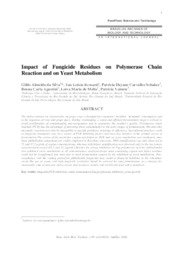Impact of fungicide residues on polymerase chain reaction and on yeast metabolism.
Impact of fungicide residues on polymerase chain reaction and on yeast metabolism.
Autoria: SILVA, G. A. da; AGUSTINI, B. C.; MELLO, L. M. R. de
Resumo: The indiscriminate use of pesticides on grape crops is harmful for consumers´ healthin “in natura” consumption and in the ingestion of wine and grape juice. During winemaking, a rapid and efficient fermentation stage is critical to avoid proliferation of contaminating microorganisms and to guarantee the product´s quality. Polymerase chain reaction (PCR) has the advantage of detecting these contaminants in the early stages of fermentation. However,this enzymatic reaction may also be susceptible to specific problems, reducing its efficiency. Agricultural practices, such as fungicide treatments, may be a source of PCR inhibiting factors and may also interfere in the normal course of fermentation.The action of the pesticides captan and folpet on PCR and on yeast metabolism was evaluated, once these phthalimide compounds are widely employed in Brazilian vineyards. DNA amplification was only observed at 75 and 37.5 µg/mL of captan concentrations, whereas with folpet, amplification was observed only in the two lowest concentrations tested (42.2 and 21.1µg/mL).Besides the strong inhibition on Taq polymerase activity, phthalimides also inhibited yeast metabolism at all concentrations analyzed.Grape must containing captan and folpet residues could not be transformed into wine due to stuck fermentation caused by the inhibition of yeast metabolism. Noncompliance with the waiting period for phthalimide fungicides may result in financial liabilities to the viticulture sector.The use of yeasts with high fungicide sensitivity should be selected for must fermentation as a strategy for sustainable wine production and to assure that products comply with health and food safety standards. Key words: fungicide;PCR inhibitors; stuck fermentation;Taq polymerase inhibitors; yeast growth
Ano de publicação: 2016
Tipo de publicação: Artigo de periódico
Unidade: Embrapa Uva e Vinho
Palavras-chave: Fungicide, PCR inhibitors, Stuck fermentation, Taq polymerase inhibitors
Observações
1 - Por padrão são exibidas publicações dos últimos 20 anos. Para encontrar publicações mais antigas, configure o filtro ano de publicação, colocando o ano a partir do qual você deseja encontrar publicações. O filtro está na coluna da esquerda na busca acima.
2 - Para ler algumas publicações da Embrapa (apenas as que estão em formato ePub), é necessário ter, no celular ou computador, um desses softwares gratuitos. Sistemas Android: Google Play Livros; IOS: iBooks; Windows e Linux: software Calibre.
Acesse outras publicações
Acesse a Base de Dados da Pesquisa Agropecuária (BDPA) para consultar o acervo completo das bibliotecas da Embrapa.

